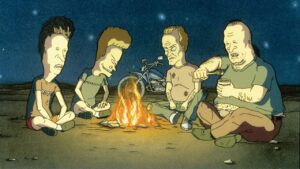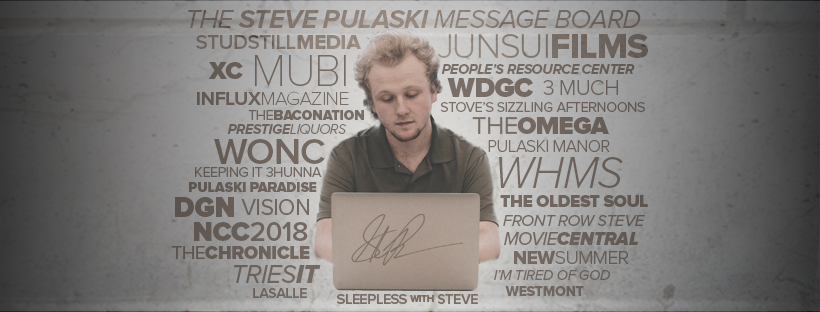Beavis and Butt-Head Do America (1996) review
Dir. Mike Judge
By: Steve Pulaski
Rating: ★★★½
Despite having seen every episode of the show, some more than a dozen times, Beavis and Butt-Head remains my go-to comfort show. However, my love for the series goes beyond that; it’s basically an obsession at this point. It’s a combination of a lot of factors. It’s the warm animation; the simplistic premises, with episodes that revolve around the two teenage Neanderthals doing everything from trying to get their ears pierced to fighting a vending machine; low-brow humor; and the soft social commentary married to the crude humor.
The child in me, who started watching Beavis and Butt-Head at far-too-young-an-age, initially found Beavis and Butt-Head Do America a touch disappointing. It was the first time the characters left their town of Highland, TX for an extended period of time, and with that meant the absence of notable supporting characters like Mr. Van Driessen, Principal McVicker, Daria, and others. Not even Stewart has much as a remote cameo. However, when revisiting it every few years, I consistently marvel at the film’s prescient depiction of America’s increasingly paranoid police state, its textured animation, and on-point humor, none of which feels dated.

Do America pairs well with South Park: Bigger, Longer & Uncut insofar that they’re two films that used their theatrical opportunity to be bolder versions of themselves, even if Mike Judge wasn’t attempting to break the latter’s record of “most swearing in an animated movie.”
The plot kicks into gear with the Beavis and Butt-Head (both voiced by Judge) awaking from a nap to realize their TV is gone. In one of the slickest gags the series has ever mustered, the camera shows us Butt-Head’s POV as his eyes travel from the broken window to the missing TV to the footsteps leading out the ajar front door, several times over, only for him to come to the conclusion that what happened “sucks.” Now they must figure out where they can watch TV.

Their wandering leads them to a scuzzy motel and into the room of Muddy Grimes (Bruce Willis), who mistakes them for the two hitmen he’s hired to “do” his two-timing wife, Dallas (Demi Moore). The prospect excites the boys. Muddy drops Beavis and Butt-Head off at the airport, where they fly to Las Vegas to meet with Dallas. The plane ride is anything but smooth, with Butt-Head attempting to flirt with a flight attendant and Beavis downing a sweet old lady’s (Cloris Leachman) caffeine pills in order to become a gibberish-spewing alter-ego Cornholio.
Long story short, the boys end up ensnared in a geopolitical scandal, the magnitude of which large enough that a pair of New York Times reporters would need to be dispatched in order to articulate the ins and outs. Dallas plants a biological weapon, known only as “the unit” on Beavis, prompting FBI Agent Fleming (Robert Stack) to dispatch all his manpower across the west coast in order to apprehend the two morons.

Judge’s film adopts the disinterested attitude and complete apathy of its protagonists. It goes big with its premise seemingly out of perfunctory obligation, experiencing the casinos of Vegas, the sights of the Hoover Dam, and the grand history of the White House with a collective shrug. Consider Do America‘s opening scene, a dream sequence in which Beavis and Butt-Head are the size of Godzilla, stomping cars and toppling skyscrapers prompting a city-wide panic. Following that is a title-card sequence with a funkadelic remix of the Beavis and Butt-Head theme with Shaft-style cross-cutting and visual references.
As if he could forecast fans’ disappointment due to the lack of music videos featured in the film, Judge and has team of animators — in the series finale of the original show said “always worked so hard to make Beavis and Butt-Head look so dumb” — create one of the most memorable sequences in the show’s history: a stirring, hypnotic visualizer that commences after Beavis unknowingly (does he ever do something “knowingly?”) eats a magic mushroom in the middle of the desert. Before his eyes, the world around him melts into a candy-colored, demonic music video with visuals directly inspired by the art of Rob Zombie. The sequence’s director was Chris Prynoski, whose credits would later include Metalocalypse.

Fun fact: the version of Ozzy Osbourne’s “Walk on Water” used in the film is a demo. Imagine how discouraged I was when the version including on the film’s OST sounded nothing like that in the film. The demo wasn’t officially released until it appeared on an Ozzy box-set, released much later. Even the Prince of Darkness himself conceded that he preferred the demo used in the film to the original version.
In the same way that the new generation of South Park fans probably assume Saddam Hussein was dead, as opposed to very much alive and still in power, when the feature film hit theaters, it’s easy to think Beavis and Butt-Head Do America was conceived in a post-9/11 world. The reactionary police force, stumblebum government response to chaos, and literal morons infiltrating the White House are all concepts that are presently so real they go beyond silly comedy. Judge’s perpetually controversial series always caught the brunt of accusations that it was contributing to the dumbing-down of society. Society didn’t need Beavis and Butt-Head to lessen the collective intelligence of the masses; that was already being done by forces bigger than anything the two knuckleheads could conceive. The same institutions have done as great of a job at that as Beavis and Butt-Head have done at being timeless, transcending the belief that they’d be a relic of the 90s and nothing more.
Distilled down to its most basic appeal, Beavis and Butt-Head Do America shows the great lengths we men will go to watch TV.
My review of Beavis and Butt-Head Do the Universe
A Brief History of the Cancelled Beavis and Butt-Head Arcade Game
Voiced by: Mike Judge, Bruce Willis, Demi Moore, Robert Stack, and Cloris Leachman. Directed by: Mike Judge.
About Steve Pulaski
Steve Pulaski has been reviewing movies since 2009 for a barrage of different outlets. He graduated North Central College in 2018 and currently works as an on-air radio personality. He also hosts a weekly movie podcast called "Sleepless with Steve," dedicated to film and the film industry, on his YouTube channel. In addition to writing, he's a die-hard Chicago Bears fan and has two cats, appropriately named Siskel and Ebert!


